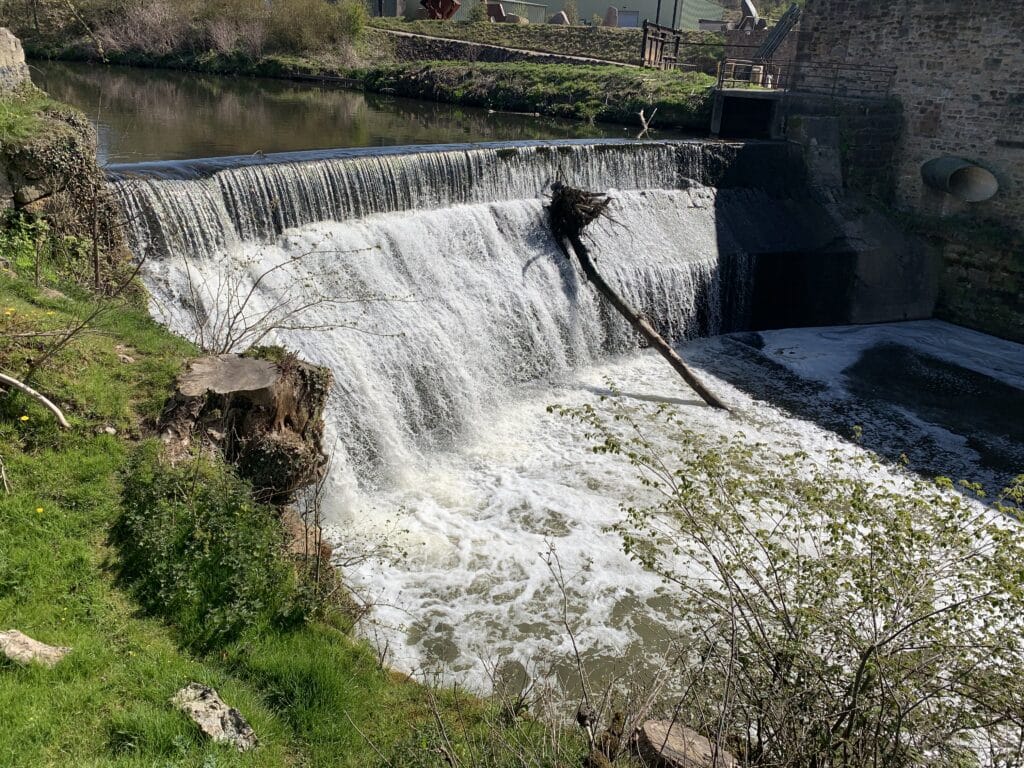
Ribble Life for Water
Ribble Life for Water is the second collaborative project to be implemented by the Ribble’s Catchment Partnership, following the flagship Ribble Life Together project.
This is actually a programme of works, rather than a project in itself. In fact, Ribble Life for Water is a set of several individual large infrastructure projects. Each of these target different areas of water around the catchment that are most in need of improvement and restoration.
Ribble Life For Water Projects
Samlesbury weir removal
Located close to the tidal area of the Ribble, Samlesbury gauging weir is a whopping 60m wide. It’s also a redundant structure which is the first barrier any migratory fish will reach in their journey up the Ribble from the sea. By removing the weir we helping fish move around the catchment more freely. Species we’re hoping to help include salmon, sea trout, smelt, eels and many more! Plus, we are also giving the river a chance to flow more naturally, which benefits all riverine species.


Long Preston flood plain restoration
The Long Preston Deeps are a really special area, and one of the most protected habitats in our catchment. Ribble Rivers Trust have been working on the 766 hectares of floodplains, 162 of which are SSSI, for a number of years. Our main goal is to remove the flood banks and restore the site to it’s natural state, which includes vast temporary wetlands. You can discover more about the work on the Long Preston Floodplain Project website.
Holland Wood weir removal
Holland Wood weir lies across the River Darwen very close to the tidal limit of the river. At around three meters high, the weir was originally built to feed a water mill at the site. Of course, the weir no longer supplies water power, but it is located near some vital infrastructure. So, we will be constructing a bypass channel around the side of the weir. This means that fish will be able to successfully migrate from the sea, to rivers, and back again.


Roach Bridge feasibility study
Roach Bridge is located on the River Darwen, just upstream from Holland Wood. The weir here is possibly the single biggest barrier to fish movement in the whole catchment. Due to it’s size, gradient, and location, any work on this structure will be very complex. Additionally, there is a functioning hydropower scheme running from the mill which further complicates matters. However, it’s important that we try and remove or pass barrier like this. So, we will be conducting a feasibility study to determine how we might improve fish passage at this weir.
Lomeshaye channel renaturalisation
On a 400m stretch of the Pendle Water, running through Lomeshaye Industrial Estate near Nelson, the river channel is lined with concrete. This dates back to the 1900s when this part of the river was a sewage works. We plan to remove this stretch of concrete from the channel, returning the river to its natural riverbed of cobbles and pebbles. Not only will this provide a much nicer habitat for wildlife, it will also reduce downstream erosion and flood risk.


Upper Ribble weir removals
Four small weirs at the upper end of the River Ribble in Yorkshire have been identified as causing problems for fish spawning. Although the barriers are only small, they prevent the natural movement of sediment and gravel downstream. By opening up these weirs, we will help restore the natural movement of gravels. This should allow more free-flowing water and hope to restore good habitat for river species. In turn, this should increase the number of fish that are able to successfully spawn.
Pendle Peat restoration
Mearley Brook begins its journey on Pendle Hill, before flowing into the River Ribble near Clitheroe. One of the main problems with Mearley Brook is that livestock overgrazing and recreation on Pendle Hill has caused severe peat erosion. This is then resulting in high levels of peat sediment entering the brook, negatively affecting water quality. As part of the Ribble Life for Water project we will be restoring some of the eroding peat gullies at the top of Pendle Hill.


Gayle Beck woody debris and woodlands
Gayle Beck is a tributary of the Ribble, flowing nearby Ribblehead. Here the river channel has been widened and straightened, and all the riverside trees have been removed. In order to return the river to a more natural state we will be adding woody material into the river to create living “woody berms”. This will provide more diverse in-river habitats and flows, helping the river flow in a more natural way. In addiiton to this we will also be creating a new woodland along the river.
Mearley Brook farm advice
Starting on Pendle Hill, Mearley Brook flows through Clitheroe and into the Ribble. As it passes through agricultural land, industrial areas, villages and towns, the Brook suffers from various pollution inputs leading to poor water quality. So, as part of Ribble Life for Water we are working to reduce these inputs. Work will include providing farm advice for landowners in the area, so they too can help reduce the runoff of peat, and other sediments and pollutants, into the Brook.


Ribble Life for Water has been granted £1.5 million by the Environment Agency and Natural England, who are jointly administering the Water Environment Grant – a fund provided by the European Agricultural Fund for Rural Development to improve the water environment in rural England.

